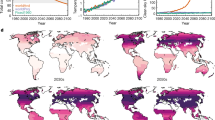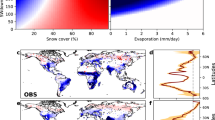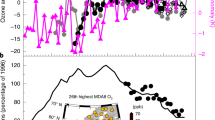Abstract
Surface ozone damages photosynthesis and reduces the ability of land ecosystems to assimilate carbon from the atmosphere thereby further increasing global warming1,2. Ozone is not emitted directly but formed in the atmosphere during complex chemical reactions of precursors, carbon monoxide, methane, non-methane volatile organic compounds and nitrogen oxides, in sunlight. These ozone precursors are emitted from a wide range of anthropogenic activities. Reductions in ozone precursor emissions are needed to mitigate ozone vegetation damage but it is unclear which are the most effective source sectors to target. Here, we apply a global Earth system model to compare the benefits to gross primary productivity of stringent 50% emission reductions in the seven largest anthropogenic ozone source sectors. Deep cuts in air pollutant emissions from road transportation and the energy sector are the most effective mitigation measures for ozone-induced gross primary productivity losses in Eastern China, Eastern United States, Europe and globally. Our results suggest that mitigation of ozone vegetation damage is a unique opportunity to contribute to negative carbon emissions, offering a natural climate solution that links fossil fuel emission abatement, air quality and climate. However, achieving these benefits requires ambitious mitigation pathways that tackle multiple source sectors.
This is a preview of subscription content, access via your institution
Access options
Access Nature and 54 other Nature Portfolio journals
Get Nature+, our best-value online-access subscription
$29.99 / 30 days
cancel any time
Subscribe to this journal
Receive 12 print issues and online access
$209.00 per year
only $17.42 per issue
Buy this article
- Purchase on Springer Link
- Instant access to full article PDF
Prices may be subject to local taxes which are calculated during checkout



Similar content being viewed by others
Data availability
Model output data relating to this study not presented in the manuscript are available from the corresponding author on request.
Code availability
The YIBs model was developed by X.Y. and N.U. and is available at https://github.com/YIBS01/YIBS_site. The source code for the frozen CMIP5/AR5 version of the GISS ModelE2 can be obtained from NASA GISS (https://www.giss.nasa.gov/tools/modelE/).
References
Sitch, S., Cox, P. M., Collins, W. J. & Huntingford, C. Indirect radiative forcing of climate change through ozone effects on the land-carbon sink. Nature 448, 791–794 (2007).
Ainsworth, E. A., Yendrek, C. R., Sitch, S., Collins, W. J. & Emberson, L. D. The effects of tropospheric ozone on net primary productivity and implications for climate change. Annu. Rev. Plant Biol. 63, 637–661 (2012).
Oliver, R. J. et al. Large but decreasing effect of ozone on the European carbon sink. Biogeosciences 15, 4245–4269 (2018).
Le Quéré, C. et al. Global carbon budget 2018. Earth Syst. Sci. Data 10, 2141–2194 (2018).
Lombardozzi, D., Levis, S., Bonan, G., Hess, P. G. & Sparks, J. P. The influence of chronic ozone exposure on global carbon and water cycles. J. Clim. 28, 292–305 (2015).
Yue, X. & Unger, N. Ozone vegetation damage effects on gross primary productivity in the United States. Atmos. Chem. Phys. 14, 9137–9153 (2014).
Yue, X. et al. Ozone and haze pollution weakens net primary productivity in China. Atmos. Chem. Phys. 17, 6073–6089 (2017).
Chang, K.-L., Petropavlovskikh, I., Copper, O. R., Schultz, M. G. & Wang, T. Regional trend analysis of surface ozone observations from monitoring networks in eastern North America, Europe and East Asia. Elem. Sci. Anth. 5, 50 (2017).
Lu, X. et al. Severe surface ozone pollution in China: a global perspective. Environ. Sci. Technol. Lett. 5, 487–494 (2018).
Jiang, F. et al. A comprehensive estimate of recent carbon sinks in China using both top-down and bottom-up approaches. Sci. Rep. 6, 22130 (2016).
King, A. W. et al. North America’s net terrestrial CO2 exchange with the atmosphere 1990–2009. Biogeosciences 12, 399–414 (2015).
Yue, X. & Unger, N. Fire air pollution reduces global terrestrial productivity. Nat. Commun. 9, 5413 (2018).
Rogelj, J. et al. in Special Report on Global Warming of 1.5 °C (eds Masson-Delmotte, V. et al.) Ch. 2 (IPCC, WMO, 2018).
Rao, S. et al. Future air pollution in the Shared Socio-economic Pathways. Glob. Environ. Change 42, 346–358 (2017).
Simon, H., Reff, A., Wells, B., Xing, J. & Frank, N. Ozone trends across the United States over a period of decreasing NOx and VOC emissions. Environ. Sci. Technol. 49, 186–195 (2015).
Yue, X. & Unger, N. The Yale Interactive terrestrial Biosphere model version 1.0: description, evaluation and implementation into NASA GISS ModelE2. Geosci. Model Dev. 8, 2399–2417 (2015).
Rogelj, J. et al. Scenarios towards limiting global mean temperature increase below 1.5 °C. Nat. Clim. Change 8, 325–332 (2018).
Turnock, S. T., Wild, O., Sellar, A. & O’Connor, F. M. 300 years of tropospheric ozone changes using CMIP6 scenarios with a parameterised approach. Atmos. Environ. 213, 686–698 (2019).
Fiore, A. M. et al. Global air quality and climate. Chem. Soc. Rev. 41, 6663–6683 (2012).
Fiore, A. M., West, J. J., Horowitz, L. W., Naik, V. & Schwarzkopf, M. D. Characterizing the tropospheric ozone response to methane emission controls and the benefits to climate and air quality. J. Geophys. Res. 113, D08307 (2008).
Felzer, B. S., Cronin, T., Reilly, J. M., Melillo, J. M. & Wang, X. Impacts of ozone on trees and crops. Comptes Rendus Geosci. 339, 784–798 (2007).
Mills, G. et al. Ozone impacts on vegetation in a nitrogen enriched and changing climate. Environ. Pollut. 208, 898–908 (2016).
Sitch, S. et al. Recent trends and drivers of regional sources and sinks of carbon dioxide. Biogeosciences 12, 653–679 (2015).
Dinerstein, E. et al. A global deal for nature: guiding principles, milestones, and targets. Sci. Adv. 5, eaaw2869 (2019).
Griscom, B. W. et al. Natural climate solutions. Proc. Natl Acad. Sci. USA 114, 11645–11650 (2017).
Schmidt, G. A. et al. Configuration and assessment of the GISS ModelE2 contributions to the CMIP5 archive. J. Adv. Model. Earth Syst. 6, 141–184 (2014).
Unger, N., Yue, X. & Harper, K. L. Aerosol climate change effects on land ecosystem services. Faraday Discuss. 200, 121–142 (2017).
Harper, K. L., Zheng, Y. & Unger, N. Advances in representing interactive methane in ModelE2-YIBs (version 1.1). Geosci. Model Dev. 11, 4417–4434 (2018).
Stohl, A. et al. Evaluating the climate and air quality impacts of short-lived pollutants. Atmos. Chem. Phys. 15, 10529–10566 (2015).
Klimont, Z. et al. Global anthropogenic emissions of particulate matter including black carbon. Atmos. Chem. Phys. 17, 8681–8723 (2017).
Yue, X. & Unger, N. Aerosol optical depth thresholds as a tool to assess diffuse radiation fertilization of the land carbon uptake in China. Atmos. Chem. Phys. 17, 1329–1342 (2017).
Mercado, L. M. et al. Impact of changes in diffuse radiation on the global land carbon sink. Nature 458, 1014–1017 (2009).
Saari, R. K., Mei, Y., Monier, E. & Garcia-Menendez, F. Effect of health-related uncertainty and natural variability on health impacts and cobenefits of climate policy. Environ. Sci. Technol. 53, 1098–1108 (2019).
Anav, A. et al. Spatiotemporal patterns of terrestrial gross primary production: a review. Rev. Geophys. 53, 785–818 (2015).
Jung, M. et al. Global patterns of land-atmosphere fluxes of carbon dioxide, latent heat, and sensible heat derived from eddy covariance, satellite, and meteorological observations. J. Geophys. Res. 116, G00J07 (2011).
Yue, X., Unger, N. & Zheng, Y. Distinguishing the drivers of trends in land carbon fluxes and plant volatile emissions over the past 3 decades. Atmos. Chem. Phys. 15, 11931–11948 (2015).
Shindell, D. T. et al. Interactive ozone and methane chemistry in GISS-E2 historical and future climate simulations. Atmos. Chem. Phys. 13, 2653–2689 (2013).
Stevenson, D. S. et al. Tropospheric ozone changes, radiative forcing and attribution to emissions in the Atmospheric Chemistry and Climate Model Intercomparison Project (ACCMIP). Atmos. Chem. Phys. 13, 3063–3085 (2013).
Bowman, K. W. et al. Evaluation of ACCMIP outgoing longwave radiation from tropospheric ozone using TES satellite observations. Atmos. Chem. Phys. 13, 4057–4072 (2013).
Sofen, E. D. et al. Gridded global surface ozone metrics for atmospheric chemistry model evaluation. Earth Syst. Sci. Data 8, 41–59 (2016).
Acknowledgements
N.U. acknowledges funding support from the University of Exeter. X.Y. acknowledges funding support from the National Natural Science Foundation of China (grant no. 41975155) and the National Key Research and Development Program of China (grant no. SQ2019YFA060013). This project was supported by the ISCA High Performance Computing facility at the University of Exeter. The authors thank K.J. van Groenigen and S. Sitch for helpful discussions.
Author information
Authors and Affiliations
Contributions
N.U. conceived the project. N.U. and Y.Z. designed the research. Y.Z. performed the simulations. X.Y. calibrated, validated and evaluated the land carbon fluxes and O3 vegetation damage in YIBs. K.L.H. developed and evaluated the dynamic CH4 simulation. N.U. and Y.Z. analysed model output. N.U. wrote the paper with all authors providing input.
Corresponding author
Ethics declarations
Competing interests
The authors declare no competing interests.
Additional information
Peer review information Nature Climate Change thanks Ben Felzer, Jin Han Park and the other, anonymous, reviewer(s) for their contribution to the peer review of this work.
Publisher’s note Springer Nature remains neutral with regard to jurisdictional claims in published maps and institutional affiliations.
Extended Data
Extended Data Fig. 1 Annual average surface O3 concentration in ppbv in the CTRL simulation.
Results shown are the decadal average for model run years 15–24. The 3 key regions are marked with black boxes: Eastern US, Europe and Eastern China.
Extended Data Fig. 2 Comparison of June-July-August (JJA) average modelled and observed surface O3 in ppbv.
Observed surface O3 is from a global gridded dataset compiled by Sofen et al40. The monitoring networks are predominantly in the US and Europe. Observations are climatological averages 2001–2010. The modelled values are from the CTRL simulation. The correlation coefficient (R) and normalized mean bias (NMB) are shown in the figure panel where N=130 is the number of grid cells used for the comparison statistics.
Supplementary information
Supplementary Information
Supplementary Tables 1–6.
Rights and permissions
About this article
Cite this article
Unger, N., Zheng, Y., Yue, X. et al. Mitigation of ozone damage to the world’s land ecosystems by source sector. Nat. Clim. Chang. 10, 134–137 (2020). https://doi.org/10.1038/s41558-019-0678-3
Received:
Accepted:
Published:
Issue Date:
DOI: https://doi.org/10.1038/s41558-019-0678-3
This article is cited by
-
Air Pollution Interactions with Weather and Climate Extremes: Current Knowledge, Gaps, and Future Directions
Current Pollution Reports (2024)
-
LESO: A ten-year ensemble of satellite-derived intercontinental hourly surface ozone concentrations
Scientific Data (2023)
-
Marginal Damage of Methane Emissions: Ozone Impacts on Agriculture
Environmental and Resource Economics (2023)
-
Ozone pollution threatens the production of major staple crops in East Asia
Nature Food (2022)
-
Occupational Exposure to Air Pollutants Among Professional Motorcyclists in Brazil Results in Higher Health Risk and Changing in Biochemical and Cardiovascular Parameters
Water, Air, & Soil Pollution (2022)



